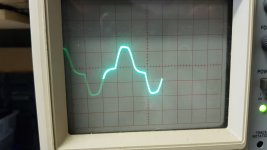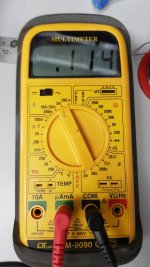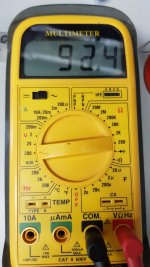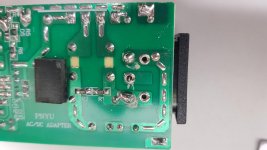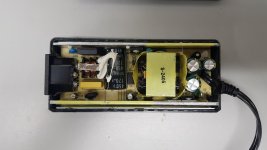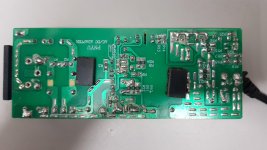I'm finalising one of my builds at the moment and was checking the safety of the finished amp when I realised there is AC on the chassis.
I am using an SMPS brick that has 3 pin AC in and 24v DC out.
Between Earth and SMPS Negative was a steady 85vac.
Tonight, there is 10vac and when shorted to ground via ammeter, I have 0.2mA. When plugged into the chassis and touching earth to chassis using one hand, there is definitely an unpleasant tingle. Wonder how unpleasant the 85v would have been..
Most importantly, is this normal / safe for an SMPS?
Should this PSU go in the bin or is it ok to use?
The amp is a self contained Bluetooth unit so it won't be grounded out via any inputs.
*Edit: I have 3 of this type of SMPS and I have 10vac, 9.8vac and 88vac.
I am using an SMPS brick that has 3 pin AC in and 24v DC out.
Between Earth and SMPS Negative was a steady 85vac.
Tonight, there is 10vac and when shorted to ground via ammeter, I have 0.2mA. When plugged into the chassis and touching earth to chassis using one hand, there is definitely an unpleasant tingle. Wonder how unpleasant the 85v would have been..
Most importantly, is this normal / safe for an SMPS?
Should this PSU go in the bin or is it ok to use?
The amp is a self contained Bluetooth unit so it won't be grounded out via any inputs.
*Edit: I have 3 of this type of SMPS and I have 10vac, 9.8vac and 88vac.
Last edited:
The laptop 'brick' is usually left floating with only a class X capacitor to reference the output to what should be earth but 9 times out of 10 it goes to live or neutral or both with 2 capacitors as an RF filter.
Connect the earth to the negative side of the output through a 10R 1W resistor. That will render it safe to use.
Connect the earth to the negative side of the output through a 10R 1W resistor. That will render it safe to use.
If it was simply leakage through a X capacitor forming part of a filter then you should get similar readings for each supply. As they are all different that raises the question of whether it is a fault. Some supplies forget about all the regulations about insulation quality and creepage distance etc.
Don't use a resistor, as that gives no safety at all. It will just remove the tingle. If a short occurs the resistor explodes, then you die.
Don't use a resistor, as that gives no safety at all. It will just remove the tingle. If a short occurs the resistor explodes, then you die.
Some supplies forget about all the regulations about insulation quality and creepage distance etc.
Interestingly, the power supplies came with all the right 'marks' (CE etc) but I guess they can print whatever they like at manufacture..
the resistor explodes, then you die.
I'd like to avoid that if possible!!
To comply with CE approval, the interference must be reduced using class X capacitors to 'leak' the interference to ground. Whether that be to earth or back to the mains.
The output can drift against earth without much of a problem. See Big Clive on youtube. He strips down many power supplies and can explain what happens better than I can.
YouTube
The output can drift against earth without much of a problem. See Big Clive on youtube. He strips down many power supplies and can explain what happens better than I can.
YouTube
Thanks Jon.
The bricks are hermetically sealed though so not sure how to go about getting a resistor in there.
Are they in an unsafe condition as is?
You can do as Jon says without getting inside the casing.
I will be less dramatic and expect you to live on for years.
The 0.2mA short-circuit current seems indeed to be a designed value, thus, not due to an uncontrolled fault mechanism.
In the past safety earth was not a standard. Being left between the choice of not connecting the chassis to anything or to some primary potential, the mid-point between phase and neutral was often used. The midpoint was formed with two safety capacitors of equal value. Most of us, having passed 50 years of age, know that tickling feeling. Had it been deadly, most of our younger forum members would never have been born as their parents would have been killed. With Jon's advice the SMPS's can probably be used.
An important issue is also if they are really worth re-use.
SMPS's with output voltages of 10vac, 9.8vac and 88vac (Vac from an SMPS?) do not sound like mainstream needs. With prices of modern SMPS, why bother with awkward output voltages? I believe those you have can still be used but you will not loose much by giving them to recycling.
The SMPS are all brand new 24vdc but also have the AC with on their negative output with respect to earth.
Any suggestions on how I could achieve that? The input jack on the chassis is metal so the SMPS negative is immediately connected at that point.
You can do as Jon says without getting inside the casing.
Any suggestions on how I could achieve that? The input jack on the chassis is metal so the SMPS negative is immediately connected at that point.
U have brand name and type? Easier if we look at data sheet.
U get different voltages at different times? Could it be the earth is not at the same potential to the live and neutral at different times? Your line being loaded differently?
Most likely the ac input and dc output is drifting a little and there shouldnt be enough leakeage to be harmful.
Any how please post datasheet or type of brick so we know what we're dealing with.
U get different voltages at different times? Could it be the earth is not at the same potential to the live and neutral at different times? Your line being loaded differently?
Most likely the ac input and dc output is drifting a little and there shouldnt be enough leakeage to be harmful.
Any how please post datasheet or type of brick so we know what we're dealing with.
They are generic Chinese made same as this:
5.5mm x 2.5mm AC 100-240V to DC 24V 5A Switching Power Supply Adapter Transformer Sale - Banggood Mobile
Don't think there would be a data sheet available for this particular one.
Neutral and Earth should be tied to the same potential here so not sure why the difference in the voltage I measured. The 85vac was present on the first ever switch on of the units, the ~10vac on subsequent switch ons.
The output is rock solid 24vdc.
5.5mm x 2.5mm AC 100-240V to DC 24V 5A Switching Power Supply Adapter Transformer Sale - Banggood Mobile
Don't think there would be a data sheet available for this particular one.
Neutral and Earth should be tied to the same potential here so not sure why the difference in the voltage I measured. The 85vac was present on the first ever switch on of the units, the ~10vac on subsequent switch ons.
The output is rock solid 24vdc.
If the DC output is isolated and floating wrt earth, you could measure literally anything AC or DC to earth from the output. The voltage will be dominated by stray capacitances and generally high impedance. The key to safety is how much current can be delivered. Hang an ammeter to earth and it better be down in the micro amp range, AC and DC, combined.
I put an ammeter on it previously and had 0.2mA on AC.
This doesn't really match up with the fact that I could feel it and couldn't keep my finger on it for more than a few seconds - that would generally indicate a value closer to 1mA (median threshold of feeling).
I need to take more measurements when I get a chance and perhaps hook the scope up to the output and see what's going on.
This doesn't really match up with the fact that I could feel it and couldn't keep my finger on it for more than a few seconds - that would generally indicate a value closer to 1mA (median threshold of feeling).
I need to take more measurements when I get a chance and perhaps hook the scope up to the output and see what's going on.
I've attached the metering readings and scope.
The waveform is 20ms period so 50Hz.
The ammeter initially read .212 then when I got camera out and did it again it was around .114.
Voltage this time was higher.
The waveform is 20ms period so 50Hz.
The ammeter initially read .212 then when I got camera out and did it again it was around .114.
Voltage this time was higher.
Attachments
Last edited:
I hope you properly earthed the AC input....I am using an SMPS brick that has 3 pin AC in and 24v DC out..
I can feel less than 0.5mA. 1mA is the usual limit for an item of equipment.avtech23 said:I put an ammeter on it previously and had 0.2mA on AC.
This doesn't really match up with the fact that I could feel it and couldn't keep my finger on it for more than a few seconds - that would generally indicate a value closer to 1mA (median threshold of feeling).
There are two things you can do:
1. Trust that the maker has designed and built these correctly, and use them in their isolated form but try to avoid touching the output.
or
2. Connect the negative directly to mains ground via a suitably thick wire so any problem will trip a breaker or blow a fuse.
I hope you properly earthed the AC input....
Yep the input is earthed via the 3 pin IEC plug. I buzzed that out and it is fine. The house earth wiring is continuous.
I tried my own 24V/5A "brick", another product of the P.R.C.
With safety earth connection, I measured 85Vrms between negative output and safety earth.
Without safety earth connected, I again measured 85Vrms between negative output and safety earth.
Then, I took my old HP 19.5V/90W "brick" made by Delta Electronics (in TW or P.R.C.?)
With safety earth connection, I measured 1.6Vrms between negative output and safety earth.
Without safety earth connected, I measured 116Vrms between negative output and safety earth.
I then tried to measure the capacitance from the negative output terminals to the earth terminals:
24V/5A P.R.C.: close to zero.
HP 19.5V/90W: 200nF.
Thus, the way the HP brick reduces the output voltage swing toward earth is with a 200nF capacitor. The P.R.C. brick has no such capacitor.
Though both bricks have a safety earth terminal, the manufacturers know they may be used from wall-connectors without safety earth. Therefore, they tie the secondary to the primary with a safety capacitor arrangement. In case safety earth is available, the HP brick uses that to tie the secondary. In both cases I see no danger, only discomfort from the tickling.
In your case you can also tie the secondary to safety earth such as suggested by Jon and DF96.
You will have to cut the power cable open to get to the earth wire and connect it to the brick output (negative wire), eventually near the DC plug. It would be a pity not to use the three bricks in particular because, those you may buy as replacement will hardly be any better.
With safety earth connection, I measured 85Vrms between negative output and safety earth.
Without safety earth connected, I again measured 85Vrms between negative output and safety earth.
Then, I took my old HP 19.5V/90W "brick" made by Delta Electronics (in TW or P.R.C.?)
With safety earth connection, I measured 1.6Vrms between negative output and safety earth.
Without safety earth connected, I measured 116Vrms between negative output and safety earth.
I then tried to measure the capacitance from the negative output terminals to the earth terminals:
24V/5A P.R.C.: close to zero.
HP 19.5V/90W: 200nF.
Thus, the way the HP brick reduces the output voltage swing toward earth is with a 200nF capacitor. The P.R.C. brick has no such capacitor.
Though both bricks have a safety earth terminal, the manufacturers know they may be used from wall-connectors without safety earth. Therefore, they tie the secondary to the primary with a safety capacitor arrangement. In case safety earth is available, the HP brick uses that to tie the secondary. In both cases I see no danger, only discomfort from the tickling.
In your case you can also tie the secondary to safety earth such as suggested by Jon and DF96.
You will have to cut the power cable open to get to the earth wire and connect it to the brick output (negative wire), eventually near the DC plug. It would be a pity not to use the three bricks in particular because, those you may buy as replacement will hardly be any better.
Last edited:
Thanks for the info.
So I decided to crack one open last night.
The earth connection from mains was not connected. There is an X2 cap across the live-neutral. Decent separation between primary and secondary.
I tidied up some of the big globs of solder and ran a heavy, double insulated single core from the earth to negative to dissipate that AC.
I'm a little nervous about bridging the primary-secondary gap with a wire but I routed it clear of everything so should be fine.
So I decided to crack one open last night.
The earth connection from mains was not connected. There is an X2 cap across the live-neutral. Decent separation between primary and secondary.
I tidied up some of the big globs of solder and ran a heavy, double insulated single core from the earth to negative to dissipate that AC.
I'm a little nervous about bridging the primary-secondary gap with a wire but I routed it clear of everything so should be fine.
Attachments
Some confusion over "class X capacitors":
Class X capacitors are connected from Line to Neutral (never from anything to safety earth). They are designed to avoid failing short-circuit, and catching on fire, in order to achieve Safety Agency rating.
Class X capacitors are added to reduce the differential-mode EMC problems caused by the converter.
Class Y capacitors are designed to connect from Line to ground, and achieve Safety-Agency rating if the are shown to avoid failing with excessive leakage.
Class Y capacitors are added to help meet EMC standards in common-mode (conducted) testing.
The leakage current arises from two routes:
- Leakage capacitance in the transformer gives leakage current from Primary→Secondary.
- EMC capacitors are often used between the trafo primary and the 0V output of the converter - this is often necessary when the converter has only a 2-pin mains input. The output is in effect used as the EMC ground return. This arrangement can cause substantial leakage.
Such a supply is OK for IT equipment, but with audio it can present some problems. The leakage current can be composed of broadband noise up to VHF, at least. Connecting it to some part of your audio system can mean common-mode noise finding its way around your signal ground network all the way up to the DAC, where broadband noise is certainly not welcome.
It's more difficult than it might seem, to eliminate the degradation from these supplies.
Class X capacitors are connected from Line to Neutral (never from anything to safety earth). They are designed to avoid failing short-circuit, and catching on fire, in order to achieve Safety Agency rating.
Class X capacitors are added to reduce the differential-mode EMC problems caused by the converter.
Class Y capacitors are designed to connect from Line to ground, and achieve Safety-Agency rating if the are shown to avoid failing with excessive leakage.
Class Y capacitors are added to help meet EMC standards in common-mode (conducted) testing.
The leakage current arises from two routes:
- Leakage capacitance in the transformer gives leakage current from Primary→Secondary.
- EMC capacitors are often used between the trafo primary and the 0V output of the converter - this is often necessary when the converter has only a 2-pin mains input. The output is in effect used as the EMC ground return. This arrangement can cause substantial leakage.
Such a supply is OK for IT equipment, but with audio it can present some problems. The leakage current can be composed of broadband noise up to VHF, at least. Connecting it to some part of your audio system can mean common-mode noise finding its way around your signal ground network all the way up to the DAC, where broadband noise is certainly not welcome.
It's more difficult than it might seem, to eliminate the degradation from these supplies.
- Status
- This old topic is closed. If you want to reopen this topic, contact a moderator using the "Report Post" button.
- Home
- Amplifiers
- Power Supplies
- That Tingly Feeling (SMPS)
